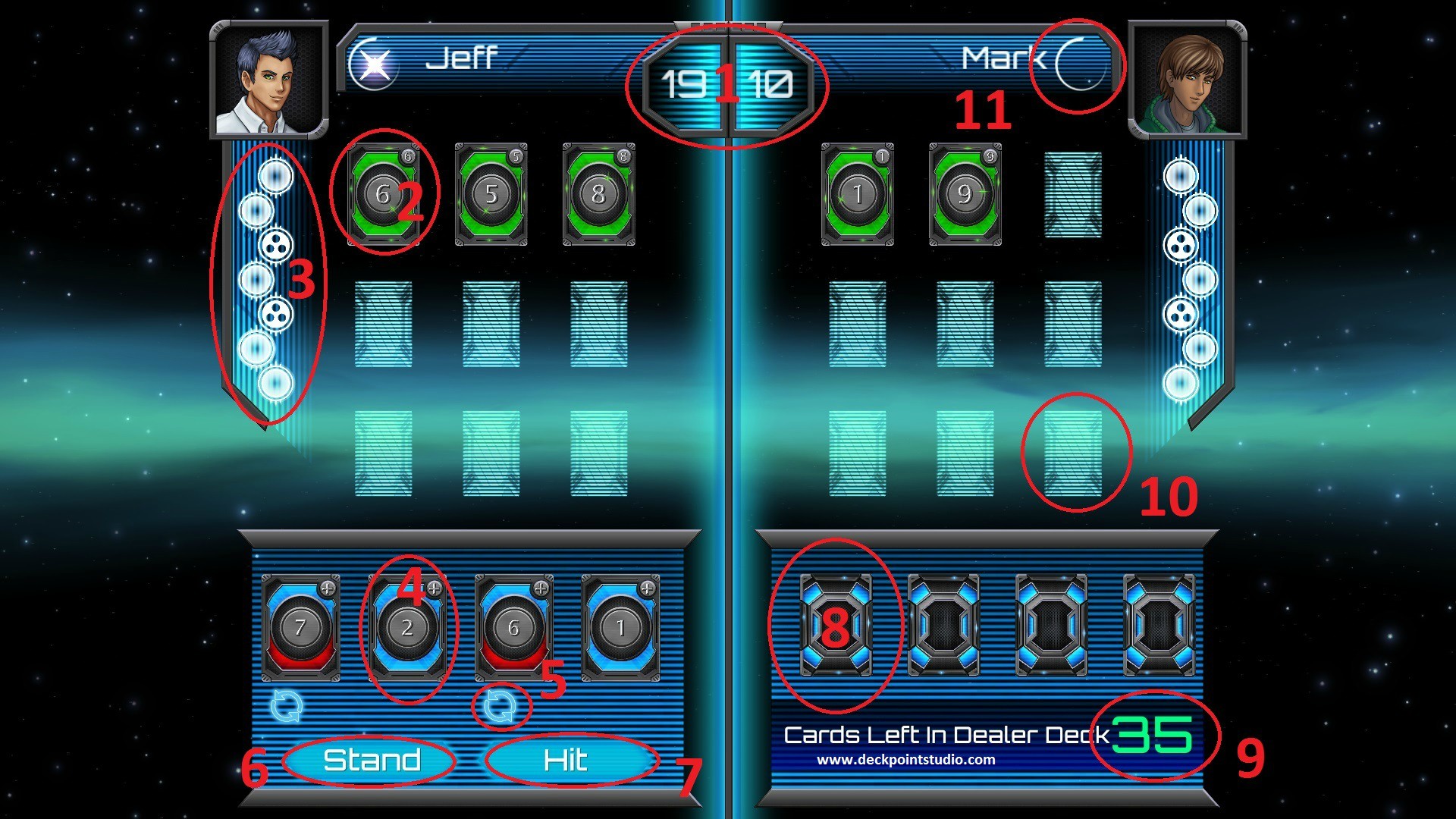
1. This area of the screen depicts the score of the two players. Each player must try to bring their score as close to 20 as possible. A player that ends their turn with a score of over 20 immediately loses the round. Players that have negative-value cards can use them to bring their score back down to 20 or below.
2. Every turn, a player is dealt a card from the main deck. These cards are green-colored and numbered from 1 - 10. The main deck contains 40 cards with 4 cards for each number. If the game goes on long enough that all 40 cards are dealt, a new deck of cards is used.
Players that keep track of the cards that have been dealt will be able to more accurately predict what future cards will be dealt. For example, if three 10-cards have already been dealt in the game, the player will know that the chances of being dealt a 10 next turn is highly unlikely.
3. The score markers represent how many rounds must be won to win the game. Depending on the game's length, cards will be dealt at certain rounds.
- When 3 rounds are necessary to win the game, no additional cards will be dealt
- When 5 rounds are necessary to win the game, 4 additional cards will be dealt when a player reaches a score of 3.
- When 7 rounds are necessary to win the game, 3 additional cards are dealt when a player reaches a score of 3, and another 3 cards when a player reaches a score of 5.
- When 9 rounds are necessary to win the game, 4 additional cards are dealt when a player reaches a score of 3, and another 4 cards when a player reaches a score of 6.
Players will keep any remaining cards they have in their hand when new cards are dealt, but their maximum hand size will always be 4. Only 1 card can be played per turn, but multiple cards can be played in a single round.
4. At the beginning of the game, players will be dealt 4 cards. Cards are color-coded based on their effect.
- Blue cards are positive and their value is added onto the player's current score
- Red cards are negative and their value is subtracted from the player's current score
- Red/blue cards have dual characteristics depending on what color is on top. If the blue color is on top, the card acts as a positive card. If the red color is on top, the card acts as a negative card. The player may flip the card to change its value.
- Yellow cards are very special and have a variety of effects. The D-card doubles the score of the last card dealt. The S-card subtracts the value of the last card played from the player's score. The T-card can be played to allow the player to win a round in the event of a tie. If both players stand on the same number, the player that played the T card wins the round.
- Yellow-T cards are very similar to the red/blue dual cards. The cards play exactly the same, except the player will win in the event of a tie. For example, if a player has a 3T card, they can play the card as a -3 or a +3. If the player and the opponent have the same score after they both stand, the player will win that round. In balanced draft mode, the amount of yellow-T cards dealt to the player is very limited.
5. Some cards can be flipped to change their effect. The player may flip a card at any point during their turn.
6. The Stand button ends all actions for the player. The player will not be dealt any additional cards and they will be unable to play cards from their hand. Players that reach a score of 20 will automatically stand when they press Hit.
7. The Hit button ends the turn for the player. The player will be dealt a new card from the main deck at the beginning of the next turn.
8. When an opponent is dealt cards, there will be a glow effect that will indicate the type of card that was dealt to them. For example, if the opponent is dealt a negative-card, the card will release a red glow when it is placed in their hand.
9. The number in the bottom right corner represents the number of cards left in the dealer's deck (the green-colored cards). When the counter hits 0, a new deck of 40 is used.
10. The field can have a maximum of 9 cards. If a player ends up filling their side of the board and they have not had their score go over 20, they will win that round.
11. Players can see the state of each player through the symbol next to the portraits. If a player has a star next to their portrait, it is their turn. A caged symbol with a red star inside means that the player is standing.


